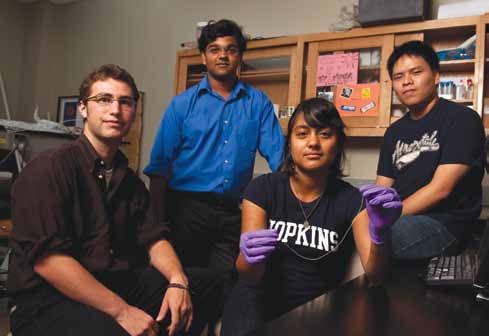
A team of Whiting School biomedical engineering students has demonstrated a practical way to embed a patient’s own adult stem cells in the surgical thread that doctors use to repair serious orthopedic injuries such as ruptured tendons. The goal: to enhance healing and reduce the likelihood of re-injury without changing the surgical procedure itself.
The 10 undergraduates, whose work was sponsored by Bioactive Surgical Inc., a Maryland medical technology company, won first place in the 2009 Design Day competition conducted by the Department of Biomedical Engineering’s Center for Bioengineering Innovation and Design (CBID). In collaboration with orthopedic physicians, the students have begun testing the stem cell–bearing sutures in an animal model, paving the way for possible human trials within about five years.
“Using sutures that carry stems cells to the injury site will not change the way surgeons repair the injury,” says team leader Matt Rubashkin ’10, “but we believe the stem cells will significantly speed up and improve the healing process. And because the stem cells will come from the patient, there should be no rejection problems.”
Bioactive Surgical developed the patent-pending concept for a new way to embed stem cells in sutures during the surgical process. The company then enlisted the student team to assemble and test a prototype to demonstrate that the concept was sound.
The students located a machine that could weave surgical thread in a way that would ensure the most effective delivery and long-term survival of the stem cells and conducted some aspects of the animal testing, although orthopedic physi- cians performed the surgical procedures. The students also prepared grant applications, seeking funding for additional testing of the technology, in collaboration with Bioactive Surgical.
“The students did a phenomenal job,” says Bioactive CEO Richard H. Spedden. Agrees Lew Schon, a Johns Hopkins foot and ankle surgeon and one of the inventors of the technology, “They have probably cut at least a year off of the development time of this technology, and they are definitely advancing the science in this emerging area.”
As envisioned by the company and the students, a doctor would withdraw bone marrow containing stem cells from a patient’s hip while the patient was under anesthesia. The stem cells would then be embedded in the novel suture through a quick and easily performed proprietary process. The surgeon would then stitch together the ruptured Achilles tendon or other injury in the conventional manner but using the sutures embedded with stem cells.
At the site of the injury, the stem cells are expected to reduce inflammation and release growth factor proteins that speed up the healing, enhancing the prospects for a full recovery and reducing the likelihood of re-injury. The team’s preliminary experiments in an animal model have yielded promising results, indicating that the stem cells attached to the sutures can survive the surgical process and retain the ability to turn into replacement tissue, such as tendon or cartilage.
That could be good news for the 46,000 people in the united States who undergo Achilles tendon repair surgery every year. The operation and subsequent therapy costs are about $40,000 per case, the students said. “After surgery, the recovery process can take up to a year. In about 20 percent of the cases, the surgery fails, and another operation is needed,” says Rubashkin. “Anything we can do to speed up the healing and lower the failure rate and the additional medical costs could make a big difference.”
Along with Rubashkin, undergraduate members of the stem cell suture design team were David Attarzadeh ’10, Raghav Badrinath ’10, Kristie Charoen ’10, Stephanie D’Souza ’12, Hayley Osen ’09, Frank Qin ’12, Avik Som ’12, Steven Su ’12, and Lawrence Wei ’09.




